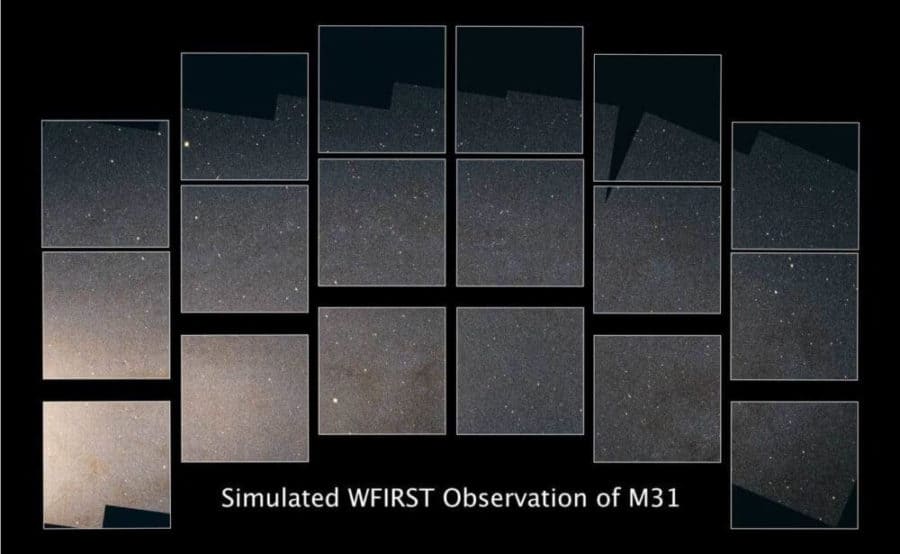WFIRST’s extraordinary survey speed is a result of its wide field of view, its agility, and its orbit. Williams explained that by covering more area in one field and being able to switch fields more quickly, “you’re avoiding all those overheads that are associated with repointing the telescope so many times.” In addition, WFIRST’s orbit one million miles out will provide a view that is generally unobstructed by Earth. While Hubble is often able to collect data during only half of its low-Earth orbit 350 miles up, WFIRST will be able to observe more-or-less continuously.
Major Survey Programs
Because it can collect so much detailed data so quickly, WFIRST is ideally suited for large surveys. A significant portion of the mission will be dedicated to monitoring hundreds of thousands of distant galaxies for supernova explosions, which can be used to study dark energy and the expansion of the universe. Another major program will involve mapping the shapes and distribution of galaxies in order to better understand how the universe — including galaxies, dark matter, and dark energy — has evolved over the past 13+ billion years.
WFIRST will also play an important role in the census of exoplanets. By monitoring the brightness of billions of stars in the Milky Way, astronomers expect to catch thousands of microlensing events — slight increases in brightness that occur when a planet passes between the telescope and a distant star. WFIRST’s ability to detect planets that are relatively small or far from their own stars — as well as rogue planets, which don’t orbit any star at all — will help fill major gaps in our knowledge of planets beyond our solar system. Although microlensing will not give us the ability to see exoplanets directly, WFIRST will also carry a coronagraph, a technology demonstration instrument designed to block enough of the blinding starlight to make direct imaging and characterization of orbiting planets possible.
These large surveys are also expected to reveal the unexpected: strange, transient phenomena that have never before been observed. “If you cover a lot of the sky, you’re going to find those rare things,” explained Williams.
Open-Access Data
Further broadening its potential impact, all of the data collected by WFIRST will be non-proprietary and immediately available to the public. Dalcanton underscored the importance of this aspect of the mission: “Thousands of minds from across the globe are going to be able to think about that data and come up with new ways to use it. It’s hard to anticipate what the WFIRST data will unlock, but I do know that the more people we have looking at it, the greater the pace of discovery.”
Complementing Other Observatories
WFIRST’s combination of talents will be a valuable complement to those of other observatories, including Hubble and the James Webb Space Telescope. “With one hundred times the field of view of Hubble, and the ability to rapidly survey the sky, WFIRST will be an extremely powerful discovery tool,” explained Karoline Gilbert, WFIRST Mission Scientist at the Space Telescope Science Institute in Baltimore, Maryland. “Webb, which is 100 times more sensitive and can see deeper into the infrared, will be able to observe the rare astronomical objects discovered by WFIRST in exquisite detail. Meanwhile, Hubble will continue to provide a unique view into the optical and ultraviolet light emitted by the objects that WFIRST discovers, and Webb follows up on.”
The simulated image is being presented at the 235th meeting of the American Astronomical Society in Honolulu, Hawaii.
WFIRST is managed by NASA’s Goddard Space Flight Center in Greenbelt, Maryland, with participation by the Jet Propulsion Laboratory (JPL) in Pasadena, California; the Space Telescope Science Institute (STScI) in Baltimore, Maryland; the Infrared Processing and Analysis Center (IPAC), also in Pasadena; and a science team comprising members from U.S. research institutions across the country, as well as international and industrial partners. WFIRST’s Science Operations Center (SOC) will reside at the STScI, which also runs science operations for Hubble and will be SOC and Mission Operations Center for the James Webb Space Telescope. All of the data collected by the WFIRST mission will be held in the Barbara A. Mikulski Archive for Space Telescopes (MAST) at STScI.
Claire Andreoli
NASA’s Goddard Space Flight Center, Greenbelt, Md.
301-286-1940
[email protected]
Margaret W. Carruthers / Christine Pulliam
Space Telescope Science Institute, Baltimore, Md.
667-218-6427 / 410-338-4366
[email protected] / [email protected]


